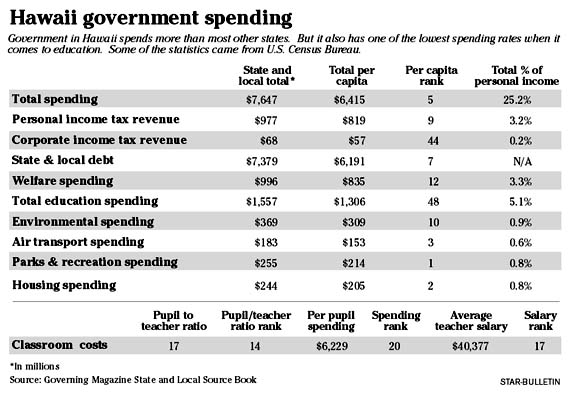

School spending Hawaii has one of the highest rates for state spending in the country and one of the lowest rates for education funding, according to a new set of statistics compiled by Governing magazine.
lagging in isles
Figures show state education
By Richard Borreca
funding is among the lowest
Star-BulletinThe survey was released in the State and Local Source Book, published by Governing Magazine, which is published monthly by Congressional Quarterly.
Peter Harkness, editor and publisher, said the statistics, many gathered from U.S. Census Bureau reports, provide "as good a measure there is of intent" of how much money state and local government is willing to spend on various government services.
The report shows that the state and counties combined spent some $7.647 billion, , which translates to a per capita rate of $6,415.
And that figure is 25.2 percent of the average personal income in Hawaii.
The per capita rank is fifth, meaning the governments in 45 states spend less per person than Hawaii.

Economists and public policy experts, however, caution that Hawaii's economic picture is different because it is a small state, with a small population, but lots of tourists who spend money and consume public services."These are the kinds of figures we really need to study a bit," notes Richard Pratt, director of the University of Hawaii's Public Administration Program, and author of Hawaii's Politics and Government. "The states don't lend themselves to easy comparisons."
Pearl Imada Iboshi, the head of the state's Research & Economic Analysis Division, also adds that the figures can't balance between states with hugely different populations, but still "they are very interesting."
"To make quick policy decisions from them would be a mistake, you have to look carefully, but they are useful to look at," she said.
For instance, the statistics show that while Hawaii is fifth in state spending, it is 48th in total education spending.
Hawaii spends $1.557 billion for education, but only $1,301 person, or 5.1 percent of the average personal income.
Our state personal income tax collects nearly a billion dollars a year, $977 million, with a per-capita ranking of ninth highest in the nation. Those figures, however, were from 1997, before the state's income tax reductions started.
Hawaii's initial welfare benefits are the highest in the country, with payments of $712 for a family of three. And Hawaii also shows the worst record of getting welfare clients off the rolls with a caseload change between 1993 and 2000 of negative-21 percent.
But Susan Chandler, director of the state Department of Human Services, says the figures don't reflect Hawaii's poor economy for much of the 1990s and don't show that the department has been successful to getting welfare clients into paying jobs. "We have become much more successful in the last two years. We keep people on the program while they are working until they get over the poverty line."
"Our numbers didn't look that good in the early days of the program, but we believe our package is very successful, because the idea is to move them into work," she said.
For instance, Chandler said the welfare rolls had 23,500 in 1997, but that number had dropped to 20,000 by July of 2000. At the same time, she added, the amount of money those welfare families had earned climbed from $3 million to $5 million a month. "It is not just a matter of taking people off the welfare rolls," she said.